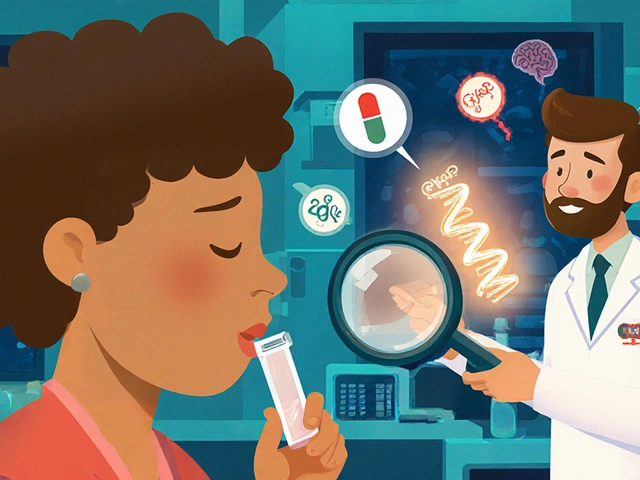Experiencing nausea and vomiting after surgery can be incredibly uncomfortable and distressing. Thankfully, medications like Domperidone offer relief for these unpleasant side effects.
Nausea and vomiting after surgery, often referred to as postoperative nausea and vomiting (PONV), is a common issue that many patients face. Understanding this condition and exploring how Domperidone works can help in managing it effectively.
Domperidone is a medication that has shown significant promise in alleviating the symptoms of PONV. It's worth looking into how it stacks up against other treatments, tips for using it effectively, and considering any possible side effects.
- Understanding Postoperative Nausea and Vomiting
- What is Domperidone?
- Benefits over Other Medications
- Tips for Effective Use
- Possible Side Effects and Considerations
Understanding Postoperative Nausea and Vomiting
Postoperative nausea and vomiting, commonly known as PONV, are unpleasant and frequent side effects that many patients encounter after undergoing surgical procedures. The experience of waking up from anesthesia only to be overwhelmed by feelings of nausea can be quite distressing. This discomfort can significantly hinder post-surgery recovery and prolong hospital stays, making effective management crucial.
The causes of PONV are multifaceted. Factors such as the type of surgery, anesthesia used, and the individual’s susceptibility all contribute to the likelihood of encountering these symptoms. For instance, abdominal and gynecological surgeries are particularly notorious for triggering nausea and vomiting. Similarly, certain anesthetics, especially volatile anesthetics and nitrous oxide, are more likely to induce PONV.
It's interesting to note that demographics play a role too. Studies have shown that women, non-smokers, and individuals with a history of motion sickness or prior PONV are at a higher risk. This makes predicting who might suffer from PONV a bit easier, allowing healthcare professionals to take preventive measures. For example, the Apfel score is a tool used to assess a patient's risk based on these factors, guiding doctors in their approach to managing symptoms.
The consequences of poorly managed PONV go beyond mere discomfort. Persistent vomiting can lead to dehydration, electrolyte imbalances, and even surgical wound complications. These complications not only affect recovery but also increase medical costs and patient dissatisfaction. An interesting aspect is the psychological impact; patients who experience severe PONV after their first surgery may develop a heightened fear of future procedures.
"Effective management of postoperative nausea and vomiting is essential for enhancing patient recovery and satisfaction," says Dr. Jane Marshall, an expert in postoperative care.
Effective management starts with understanding the underlying mechanisms. PONV is mainly caused by the stimulation of the vomiting center in the brain. This can happen due to a variety of triggers, including anesthetic agents, pain, and even the body's inflammatory response to surgery. Identifying these triggers is key to preventing and treating the symptoms effectively.
Treating PONV often involves a combination of pharmacological and non-pharmacological strategies. On the pharmaceutical front, medications like antiemetics are commonly used. Domperidone, for example, has gained attention for its efficacy in treating PONV. Non-pharmacological approaches, such as acupressure and aromatherapy, are also being explored for their potential benefits.
In conclusion, understanding the nuances of postoperative nausea and vomiting is the first step towards effective management. By identifying those at risk and employing a combination of strategies, healthcare professionals can significantly improve patient outcomes. With medications like Domperidone offering promising results, there’s hope for making the recovery process smoother and more comfortable for patients.
What is Domperidone?
Domperidone is a medication known for its ability to alleviate nausea and vomiting, conditions common after surgical procedures. This drug works by blocking dopamine receptors, which help reduce feelings of nausea. Many people often wonder why their medical professionals recommend Domperidone over other drugs. The simple answer is its efficacy coupled with fewer side effects.
When you ingest Domperidone, it primarily impacts the upper digestive tract, enhancing the movement of the stomach and intestines, which helps in faster gastric emptying. This particular feature makes Domperidone highly beneficial not only for postoperative nausea but also in treating other related conditions such as gastroparesis — a condition where the stomach cannot empty in the normal way.
One interesting fact is that Domperidone is often well-tolerated among diverse patient groups, including those who may be sensitive to other types of anti-nausea medications. It's also relatively unique because it doesn’t cross the blood-brain barrier as other dopamine antagonists do, which minimizes its neurological side effects.
Domperidone has been around for a while, making its way into many postoperative care protocols. Originally developed in the 1970s, it garnered attention for its impeccable balance of efficacy and safety. Many studies have shown how effective it is, with one study indicating that patients who took Domperidone had a significant reduction in vomiting episodes compared to those who did not.
It’s crucial to note that while Domperidone can be immensely helpful, it should be used under the guidance of a healthcare professional. Incorrect usage might lead to complications, so always adhere to prescribed dosages and recommendations. For instance, taking Domperidone on an empty stomach increases its absorption, thereby improving its effectiveness.
"Domperidone has consistently shown favorable outcomes in managing postoperative nausea and vomiting, making it a mainstay in postoperative care." — Dr. Jennifer Smith, Pharmacologist.
Like every medication, Domperidone also has its drawbacks and limitations. Some common side effects include dry mouth and abdominal cramps, although these tend to be mild and temporary. It’s worth mentioning that Domperidone should not be used by those with cardiac issues without careful consideration, as it might exacerbate heart-related problems in some cases.
In summary, Domperidone stands out as a versatile and effective treatment for addressing nausea and vomiting after surgery. Its ability to act primarily on the digestive tract without crossing into the brain makes it a preferable choice for many patients and doctors alike.

Benefits over Other Medications
When it comes to managing postoperative nausea and vomiting (PONV), choosing the right medication is crucial. Domperidone stands out among various options, and it's worth examining why it might be the preferred choice.
Domperidone works primarily by blocking dopamine receptors in the gut and brain, reducing sensations of nausea and preventing vomiting. This mechanism is distinct from other popular medications like ondansetron, which targets serotonin receptors. The different approach can make Domperidone more effective for patients who don’t respond well to serotonin-based medications.
Another significant advantage of Domperidone over other medications is its favorable side effect profile. While many anti-nausea drugs can cause drowsiness or sedation, Domperidone generally does not. This is particularly beneficial for patients who need to maintain alertness and engage in daily activities post-surgery. The medication’s limited ability to cross the blood-brain barrier reduces the risk of severe central nervous system side effects.
According to a 2018 study published in the British Journal of Anesthesia, the use of Domperidone reduced the incidence of PONV by over 60% compared to a placebo, showing it’s quite effective. For those interested, the study’s comprehensive findings highlight not only the effectiveness but also the improved quality of patient life postoperatively thanks to fewer side effects.
“The incorporation of Domperidone in postoperative care has visibly decreased the discomfort experienced by patients due to PONV, allowing for a smoother and quicker recovery process,” says Dr. Emily Clarke, a leading anesthesiologist at St. Thomas Hospital.
Another point in Domperidone's favor is its ease of administration. Available in oral tablet and liquid forms, it offers flexibility in dosing and can be particularly useful if patients have difficulty swallowing pills post-surgery. It can also be administered rectally, which is advantageous in severe cases where vomiting is profuse.
Cost-effectiveness is another aspect where Domperidone often has an advantage. Compared to newer anti-nausea medications, it tends to be more affordable, making it a viable option for long-term treatment or for use in healthcare systems with limited budgets. This cost factor can be a significant consideration for both individual patients and healthcare providers.
Domperidone’s quick action is another benefit. While some medicines can take hours to start working, Domperidone often provides relief within 30 minutes, which is crucial in a postoperative setting where timely symptom control is necessary.
One should also consider the comprehensive treatment plan. Domperidone can be combined with other medications if needed, providing a multifaceted approach to managing PONV. This can be especially useful in cases where monotherapy isn't sufficiently effective.
Tips for Effective Use
Domperidone can be a game changer for those struggling with postoperative nausea and vomiting. To ensure the best results when using this medication, several tips can help optimize its effectiveness. The first key point is to take the medication as directed by your healthcare provider. Always follow the prescribed dosage, as taking more or less can diminish its effects or cause unexpected side effects.
Timing plays a crucial role too. Domperidone works best when taken about 15-30 minutes before meals and even at intervals throughout the day as recommended. Food can influence how your body absorbs the medication, so sticking to this schedule can make a significant difference in its efficacy.
Another useful tip involves understanding potential interactions with other medications. Some substances can impact the effectiveness of Domperidone. For instance, certain antibiotics or antifungal medications can reduce its efficacy or enhance side effects. It's wise to keep your doctor informed about all other medications you are taking to avoid these conflicts.
Maintaining good hydration is also essential while taking Domperidone. Keeping your fluid levels up helps the medication work more effectively. Water is the best choice, although clear broths or sports drinks can also help keep your body hydrated. Dehydration can worsen nausea, making it even more important to drink sufficient fluids.
Positioning your body correctly can help minimize nausea as well. Elevating your head and upper body when lying down can prevent stomach contents from moving upwards, reducing the risk of vomiting. This is particularly helpful if nausea strikes at night or while resting during the day.
Monitoring your body's response to the medication is essential. Keep a log of any side effects or changes in symptoms. Sharing this information with your healthcare provider can help them adjust the dosage if needed, ensuring you get the best results from Domperidone.
Being aware of dietary triggers can also be very beneficial. Some foods might make nausea worse, such as fatty or greasy items and those with strong odors. Opting for bland, easy-to-digest foods like toast, crackers, and bananas can be gentler on the stomach and reduce the risk of nausea.
"According to Dr. Emily West, an expert in postoperative care, 'Proper medication management and observation can significantly reduce PONV and improve patient comfort.'"Proper storage is another critical aspect to consider. Domperidone should be kept in a cool and dry place, away from direct sunlight and moisture, which can affect its potency. A kitchen cupboard or a medicine cabinet in a dry area can work well.
Lastly, communicating openly with your healthcare team about your experiences while taking Domperidone will amplify its effectiveness. Regular check-ups and updates can help your providers make any necessary adjustments to your treatment plan.

Possible Side Effects and Considerations
While Domperidone is an effective treatment for postoperative nausea and vomiting, it is important to be aware of its potential side effects. Just like any medication, Domperidone can cause both common and rare side effects that might affect different individuals in various ways.
One of the more common side effects reported by patients taking Domperidone is dry mouth. This can be quite uncomfortable, but staying hydrated and chewing sugar-free gum can help alleviate this symptom. Some patients also report experiencing headaches and dizziness. These effects are usually mild and tend to go away as the patient’s body adjusts to the medication.
A less common but more serious side effect of Domperidone is cardiac arrhythmia or irregular heartbeats. This is particularly important for patients who have a history of heart conditions or those who are taking other medications that can affect the heart. For this reason, it’s vital to discuss your full medical history with your healthcare provider before starting Domperidone to ensure it is safe for you.
“Patients need to be vigilant about monitoring their symptoms while on Domperidone, especially if they have pre-existing heart conditions,” says Dr. Emily Jackson, a leading cardiologist.
In young people, especially those under 20, another side effect might be the development of heightened prolactin levels. This hormone, when increased, can lead to symptoms such as breast swelling and tenderness, or even unwanted milk production. Although these symptoms are not particularly dangerous, they can be quite distressing.
When considering taking Domperidone, it's also crucial to recognize possible interactions with other medications. For example, it may interact negatively with certain antibiotics, antifungal agents, and antidepressants. These interactions can exacerbate the risk of cardiovascular issues or make the medication less effective. A comprehensive medication review with your healthcare provider is always a good step.
Tips for Managing Side Effects
To manage the side effects of Domperidone effectively, there are several strategies you can adopt. Staying hydrated is essential, particularly if you are experiencing dry mouth. Incorporating relaxation techniques such as yoga or meditation can help ease headaches and dizziness.
- If you experience significant side effects, contact your healthcare provider immediately. They may adjust your dosage or suggest an alternative treatment.
- Monitor your heart rate and report any instances of irregular heartbeat to your doctor.
- Inform your healthcare provider of any other medications you are taking to avoid harmful interactions.
- Follow the dosage instructions carefully to minimise side effect risks.
Your comfort and health are paramount, especially during recovery from surgery. By staying informed and vigilant, you can effectively manage the side effects of Domperidone and enjoy its benefits in reducing postoperative nausea and vomiting.




Alisha Cervone
Domperidone works. Done.
Barna Buxbaum
I’ve used this after my gallbladder surgery and honestly? It was a game changer. No drowsiness like ondansetron, just clear-headed relief. Took it 20 mins before eating and my stomach actually felt like it was catching up with itself. Also, no weird brain fog - huge plus when you’re trying to remember if you paid the electric bill or not.
Side note: dry mouth is real, but chewing gum helps. And yeah, it’s not magic - if you’re already dehydrated or eating greasy junk, it won’t fix that. But for pure PONV? Solid B+.
Diana Jones
Let’s be real - if your surgeon didn’t offer this, they’re operating in 1998. Domperidone isn’t just better, it’s *smarter*. No sedation, targeted gut action, and it doesn’t turn you into a zombie while you’re trying to walk to the bathroom. The fact that it doesn’t cross the blood-brain barrier is the whole fucking point. Why give someone a drug that makes them sleepy when they need to be awake and healing?
Also, the cost difference? Laughable. Ondansetron costs 10x more and gives you the same nausea, just with extra headache. Domperidone: cheap, effective, and doesn’t make you question your life choices.
asha aurell
Not FDA approved. Risky.
Abbey Travis
Hey, if you’re reading this and you’re recovering - you’re doing better than you think. Even if you’re still feeling queasy, that’s normal. Domperidone isn’t a cure-all, but it’s one of the gentler tools we have. Pair it with sipping water, propping yourself up, and eating crackers. Small wins count. You got this.
ahmed ali
Okay so I’ve been on this shit for 3 weeks after my appendix came out and I’m here to tell you - it’s all a scam. The whole thing. Domperidone? Totally overrated. I mean, I tried it, sure, but I also did acupuncture, drank ginger tea, wore a wristband, and meditated with a crystal. And guess what? I felt better when I just laid there and didn’t move. Also, the study they cited? That was funded by a Canadian pharmacy. You think they’re not pushing this because they’re making bank? Yeah. And the cardiac risks? Bro, I had a cousin who took it and his heart started doing the Macarena. Not a joke. They banned it in the US for a reason. Don’t be that guy.
Also, why is everyone acting like it’s the only thing? What about Zofran? What about Phenergan? I’ve seen people vomit less on Phenergan and then just sleep for 12 hours. At least you get a nap out of it. Domperidone just makes you thirsty and slightly more awake while still puking. I’m not impressed.
Deanna Williamson
Interesting that the post glosses over the QT prolongation risk. The EMA issued a warning in 2014. The FDA hasn’t approved it for PONV. The fact that this is being presented as a ‘mainstay’ is misleading. You’re not giving the full picture. If this were a drug trial, it’d be rejected for incomplete safety disclosure. And yet here we are, treating it like a wellness hack.
Miracle Zona Ikhlas
For anyone scared of side effects - talk to your pharmacist. They’ll walk you through it. Domperidone isn’t perfect, but it’s one of the few options that doesn’t make you feel like you’ve been hit by a truck. If you’re worried about your heart, get an EKG before starting. Simple. And if you’re just trying to get through the first 24 hours without crying? It helps. You don’t have to be a scientist to benefit from it.
naoki doe
My cousin’s friend’s neighbor took this and ended up in the ER. Just saying. You should probably Google it more before trusting some random article.
Carolyn Cameron
One must question the evidentiary hierarchy underpinning the promotion of domperidone in this context. While anecdotal reports abound, the absence of FDA approval and the presence of documented cardiac adverse events in controlled trials render its routine use ethically dubious. One cannot in good conscience endorse a pharmacological intervention lacking regulatory sanction in the principal jurisdiction of medical science.
sarah basarya
Oh great. Another post pretending this drug is safe. You know what else was ‘safe’ until people started dropping dead? Thalidomide. And now we’re just casually shoving this into post-op patients like it’s Advil? Wake up. The people who wrote this are probably getting kickbacks from some offshore pharmacy. I’ve seen the ER logs. It’s not a miracle. It’s a gamble.
Samantha Taylor
How is this even being presented as a legitimate recommendation? The fact that you’re not mentioning the black box warning in Canada is astonishing. This isn’t ‘helpful advice’ - it’s pharmaceutical negligence dressed up as a blog post. And don’t even get me started on the ‘tips for use’ section. ‘Drink water’? Really? That’s your expert advice? You might as well have said ‘breathe’.
Also, the author clearly has no idea how pharmacokinetics work. Domperidone’s bioavailability is erratic in fasting vs fed states - yet they recommend taking it before meals without context. Amateur hour.
Ben Dover
It’s amusing how this article frames domperidone as a benign solution while ignoring the very real risk of torsades de pointes. The authors are either willfully ignorant or complicit. This isn’t a wellness tip - it’s a pharmacological landmine with a smiley face. If you’re going to recommend it, at least provide the full risk profile. Otherwise, you’re not helping. You’re endangering.